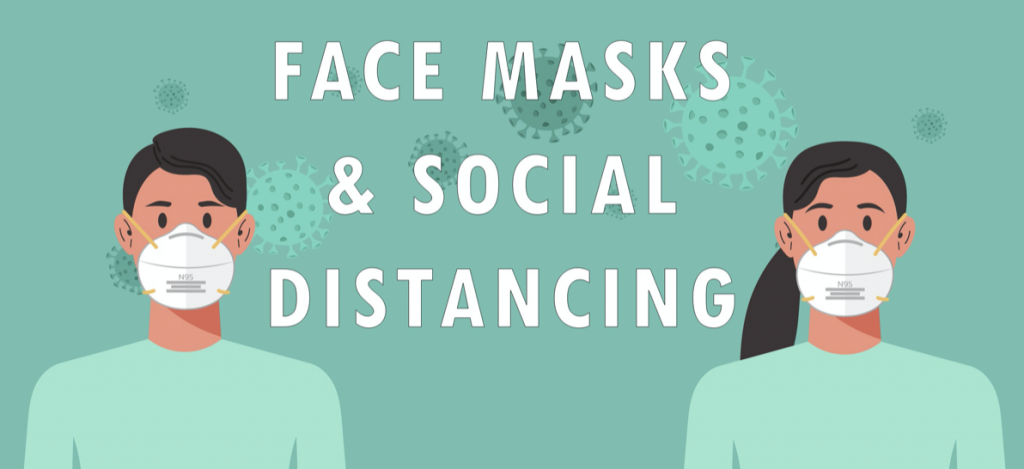
Masks and social (physical) distancing are sometimes seen as either/or propositions, but that is often not the case.
In fact, Ontario’s emergency public health regulations for post-secondary institutions stipulate that on top of mask policies, physical distancing of at least two metreas must also be maintained at all times.
The law also sets out the maximum number of people who may be allowed into a learning space at one time with masks and social distancing protocols. You can read the full legal guidelines below:
Reopening Ontario (A Flexible Response to COVID-19) Act, 2020
FORMERLY UNDER EMERGENCY MANAGEMENT AND CIVIL PROTECTION ACT
RULES FOR AREAS IN STAGE 2
RED ZONE
https://www.ontario.ca/laws/regulation/200263
In-person teaching and instruction
6. (1) Subject to subsection (3), the person responsible for a business or place that is open and that provides in-person teaching or instruction shall ensure that every instructional space complies with the following conditions:
1. The instructional space must be operated to enable students to maintain a physical distance of at least two metres from every other person in the instructional space, except where necessary for teaching and instruction that cannot be effectively provided if physical distancing is maintained.
2. The total number of students permitted to be in each instructional space at any one time must be limited to the number that can maintain a physical distance of at least two metres from every other person in the business or place, and in any event cannot exceed,
i. 10 persons, if the instructional space is indoors, or
ii. 25 persons, if the instructional space is outdoors.
(2) Paragraph 2 of subsection (1) does not apply to a post-secondary institution, and instead the total number of students permitted to be in each instructional space in the institution at any one time must be limited to the number that can maintain a physical distance of at least two metres from every other person in the space, and in any event cannot exceed,
(a) 50 persons, if the instructional space is indoors; or
(b) 100 persons, if the instructional space is outdoors.
Reopening Ontario (A Flexible Response to COVID-19) Act, 2020
FORMERLY UNDER EMERGENCY MANAGEMENT AND CIVIL PROTECTION ACT
RULES FOR AREAS IN STAGE 1
GREY ZONE
https://www.ontario.ca/laws/regulation/200082
SCHEDULE 3
PLACES THAT MUST CLOSE OR THAT ARE SUBJECT TO CONDITIONS
Post-secondary institutions
2. (1) Post-secondary institutions may only open if they meet the following conditions:
1. In-person teaching or instruction may only be provided if the following conditions are met:
i. The subject matter of the teaching or instruction requires that it be taught in-person, such as clinical training or training related to a trade.
ii. The instructional space must be operated to enable students to maintain a physical distance of at least two metres from every other person in the instructional space, except where necessary for teaching and instruction that cannot be effectively provided if physical distancing is maintained.
iii. The total number of students permitted to be in each instructional space at the institution at any one time must be limited to the number that can maintain a physical distance of at least two metres from every other person in the business or place, and in any event cannot exceed,
A. 50 persons, in the case of an instructional program described in subsection (1.1), and
B. 10 persons, in any other case.
2. If in-person teaching or instruction at the institution involves singing or the playing of brass or wind instruments,
i. every person who is singing or playing must be separated from every other person by plexiglass or some other impermeable barrier, and
ii. every person in the instructional space must remain at least two metres apart from every other person in the instructional space.
3. Any in-person examinations must be provided in accordance with the following rules:
i. Every person in the examination room must remain at least two metres apart from every other person in the examination room.
ii. The total number of persons who may take the examination in the same room at the same time cannot exceed,
A. 50 persons, in the case of an examination for an instructional program described in subsection (1.1), and
B. 10 persons, in any other case.
(1.1) An instructional program referred to in sub-subparagraphs 1 iii A and 3 ii A of subsection (1) is an instructional program in any of the following fields or an instructional program to train an individual for any of the following occupations, as the case may be:
1. Diagnostic cardiac sonography.
2. Diagnostic medical sonography.
3. Diagnostic ultrasound.
4. Medical imaging.
5. Medical laboratory assistant.
6. Medical laboratory technician.
7. Medical radiation technology.
8. Medicine.
9. Mental health and addictions services, including psychology services, social work services and counselling services.
10. Nursing.
11. Paramedic.
12. Personal support worker, supportive care worker, home care worker or a similar occupation.
13. Pharmacy/pharmacy technician.
14. Public health inspector, if the program is accredited by the Canadian Institute of Public Health Inspectors.
15. Rehabilitation sciences (nutrition, speech language pathology, occupational science, and physiotherapy).
16. Respiratory therapy.
(2) In this section,
“post-secondary institution” means,
(a) a university,
(b) a college of applied arts and technology,
(c) a private career college,
(d) an Indigenous Institute prescribed for the purposes of section 6 of the Indigenous Institutes Act, 2017,
(e) an institution that is authorized to grant a degree by an act of the Legislature,
(f) a person who is delivering in-person teaching or instruction in accordance with a consent given under section 4 of the Post-secondary Education Choice and Excellence Act, 2000,
(g) a person approved to provide training for apprenticeship programs under paragraph 5 of section 64 of the Ontario College of Trades and Apprenticeship Act, 2009, or
(h) any other institution that is a designated learning institution within the meaning of section 211.1 of the Immigration and Refugee Protection Regulations (Canada), other than a school or private school within the meaning of the Education Act.
